Pizza Dough
This post may contain affiliate links. Read my full disclosure policy.
Elevate your homemade pizzas with this simple and delicious pizza dough, made with just five ingredients.
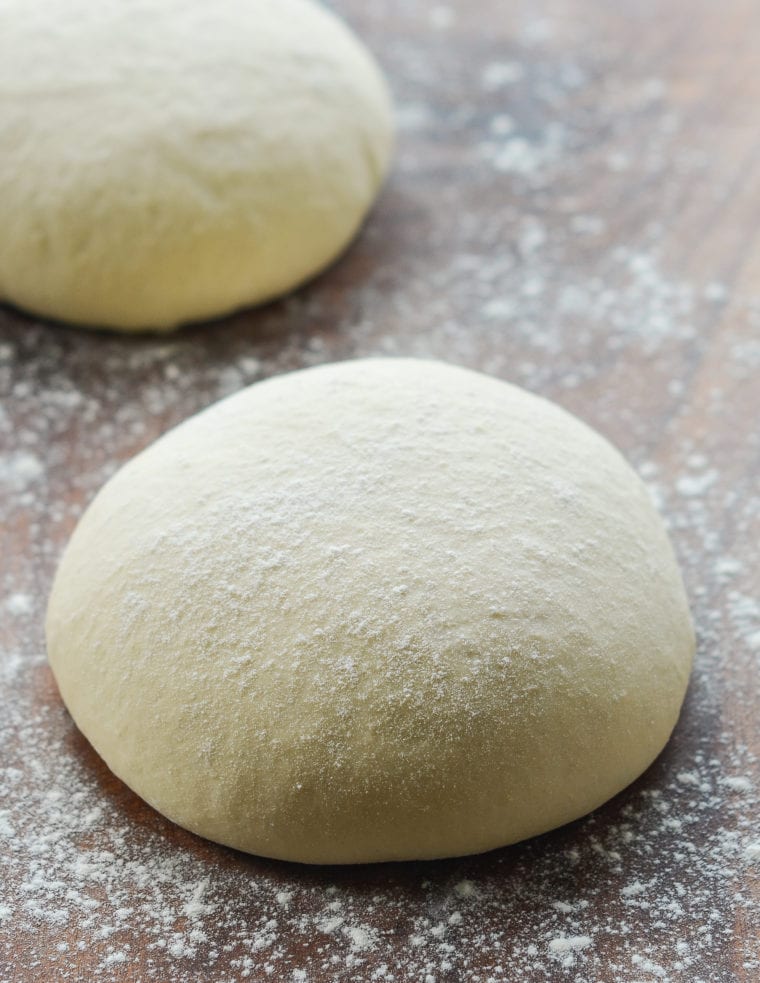
If you want to ensure a perfect crust for your homemade pizza, stromboli, or calzones, making your own pizza dough is the way to go. This simple process requires five basic ingredients — flour, salt, yeast, oil, and water — and takes only ten minutes to mix and knead. Just be sure to allow at least 90 minutes for the pizza dough to rise in a warm, draft-free spot in your kitchen before using it. This recipe makes 2 pounds of dough, which is enough for two large pizzas, four individual ones, two stromboli, or four calzones. You can make the dough up to two days in advance, and it freezes beautifully, too.
What you’ll need to make pizza dough
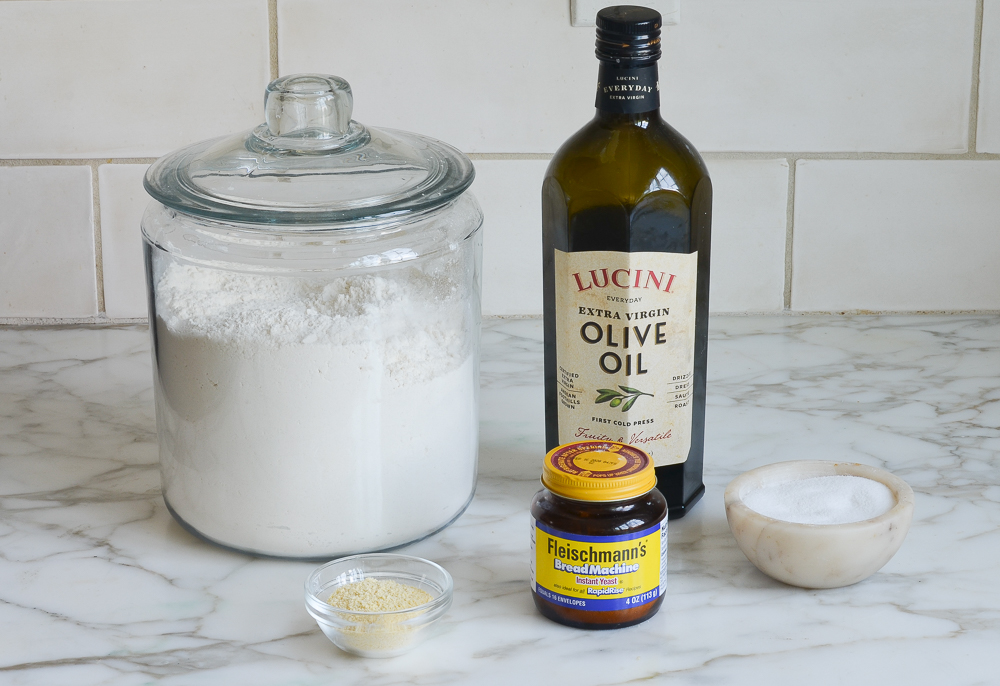
- Olive oil adds richness to the dough and helps it crisp up in the oven.
- A healthy dose of salt is added for flavor.
- Cornmeal is used to dust the baking sheet and keep the dough from sticking as it bakes; it also gives the crust a bit of extra crispiness and flavor.
- Yeast makes the dough rise. I use instant yeast, which may also be referred to as rapid-rise, quick-rise, or bread machine yeast (this is confusing, but they are all the same thing). Active dry yeast, often referred to as regular yeast, may also be used, but it will lengthen the rising time by about 50%.
Step-By-Step Instructions
Mix the Dough
To begin, combine the flour, yeast, and salt in the bowl of a stand mixer.
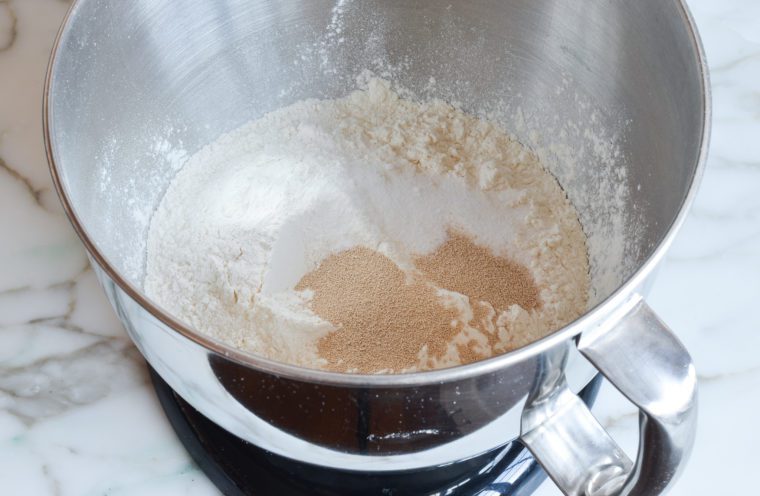
Stir with a spoon to combine, and then add the oil and warm water.
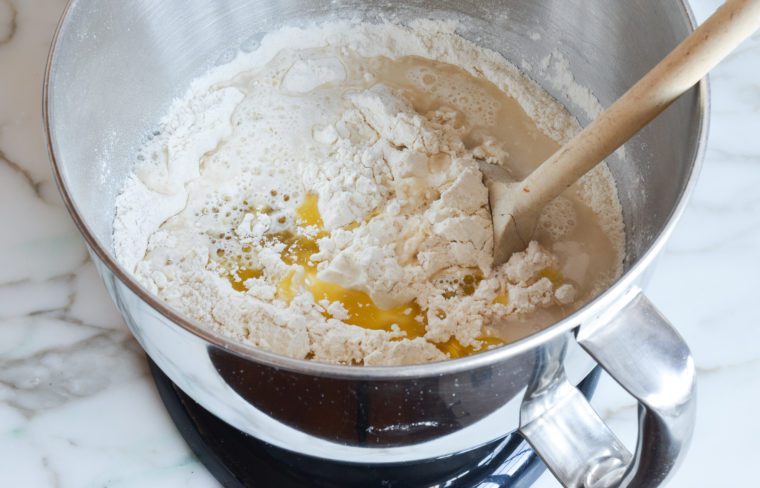
Stir until the dough comes together into a shaggy mass.
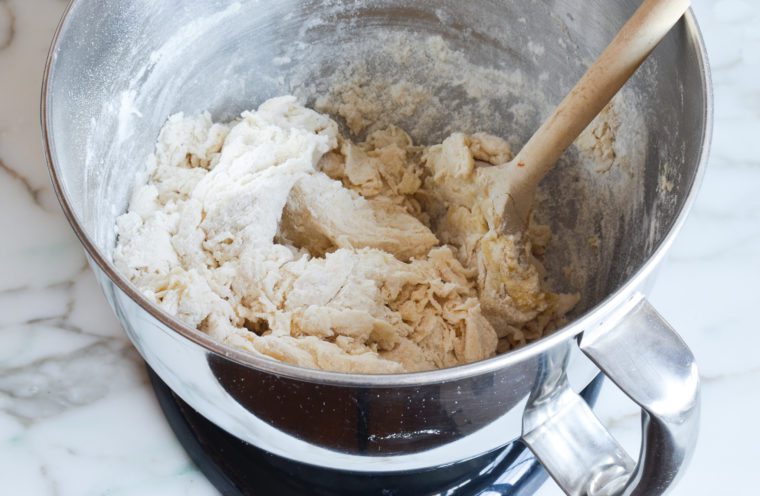
Knead the Dough
Fit the mixer with the dough hook and knead on medium-low speed until the dough is smooth and elastic, 5 to 7 minutes. (Alternatively, you can knead the dough by hand.)
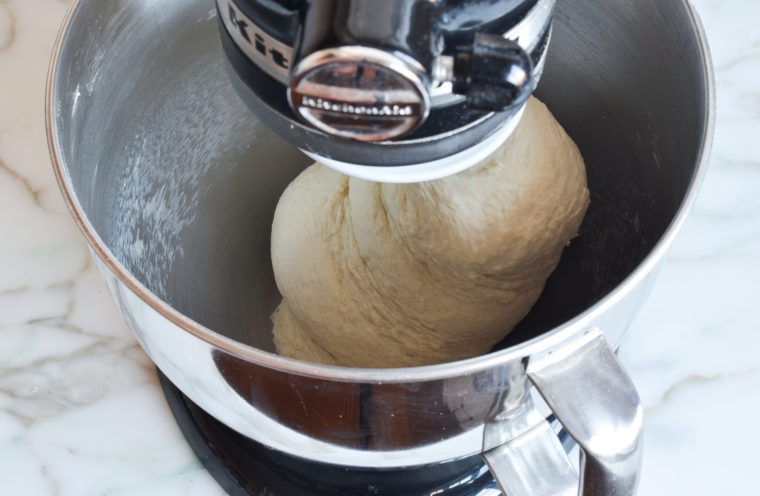 Let the Dough Rise
Let the Dough Rise
Transfer the dough to a lightly oiled large bowl.
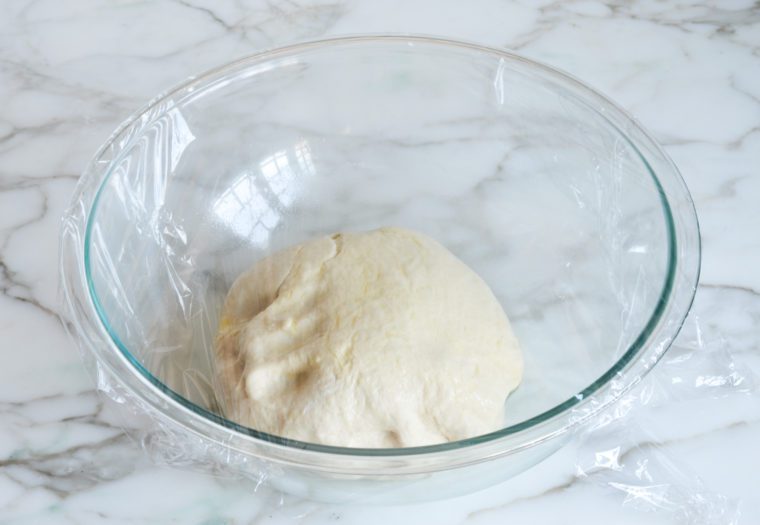
Cover the bowl with plastic wrap or a damp kitchen towel, and let the dough rise in a warm place until it has doubled in size, 1 to 2 hours.
There are a number of options that will work as places to let your dough rise: a sunny spot in your house, next to a heating vent (during colder months), or even on top of a kitchen appliance that generates a bit of heat as it runs (like your fridge). If you’re lucky enough to have a proof setting in your oven, use that. If not, but you’d like to use your oven, switch on the oven’s internal light; it will generate enough warmth to provide a good environment for the dough to rise.
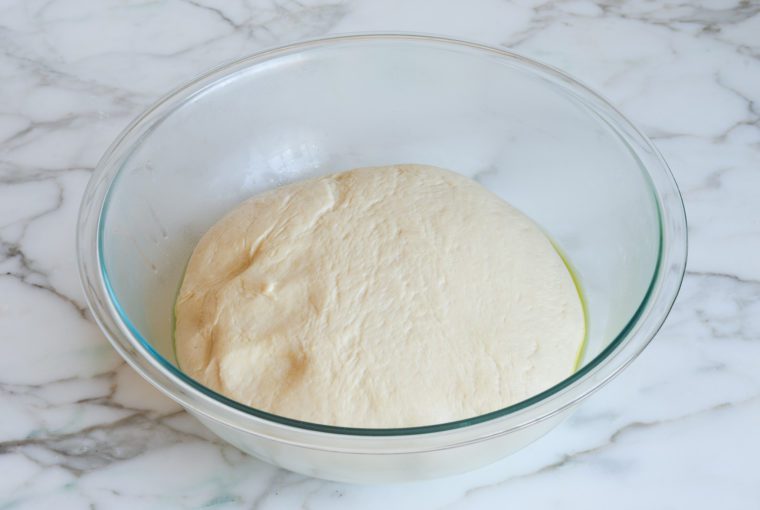
After the dough has risen, punch it down.
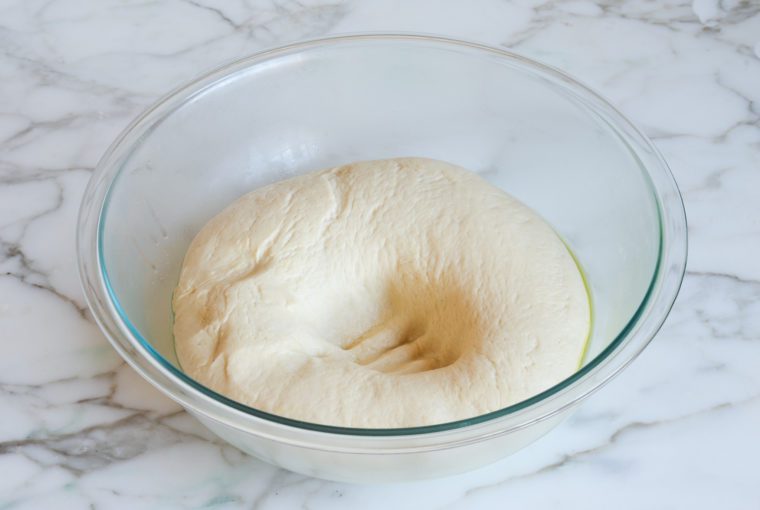
Place the dough on a lightly floured surface. Cut the dough in half and roll each piece into a ball. If you’re not using the pizza dough right away, lightly coat the dough ball(s) with olive oil. Place into freezer bag(s) and seal shut, squeezing out all the air. Refrigerate for up to 2 days. When ready to use, let the dough sit out on the countertop for 30 minutes to warm up before stretching.
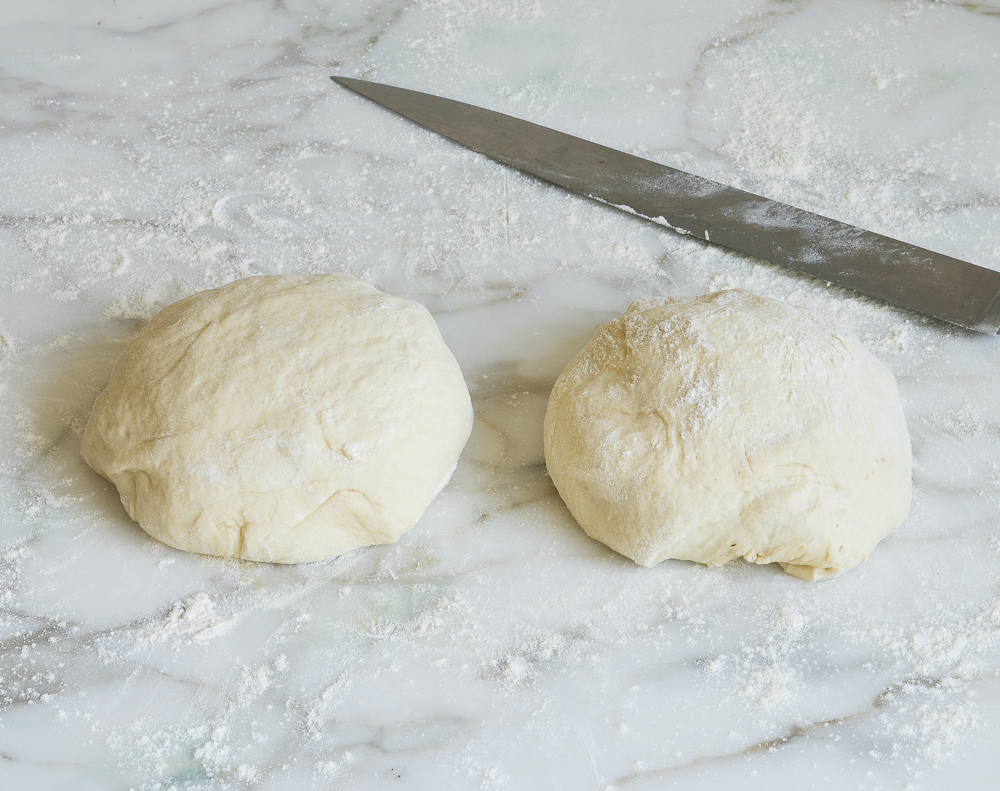
Cover the dough with a damp kitchen towel and let it rest for 15 to 20 minutes.
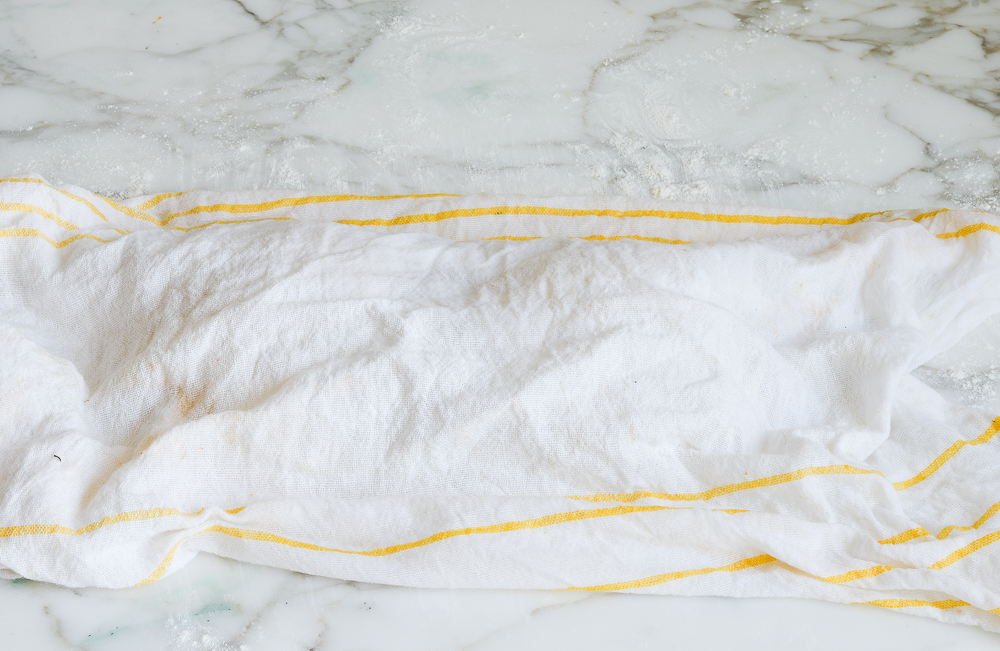
As you can see, it will rise a bit.
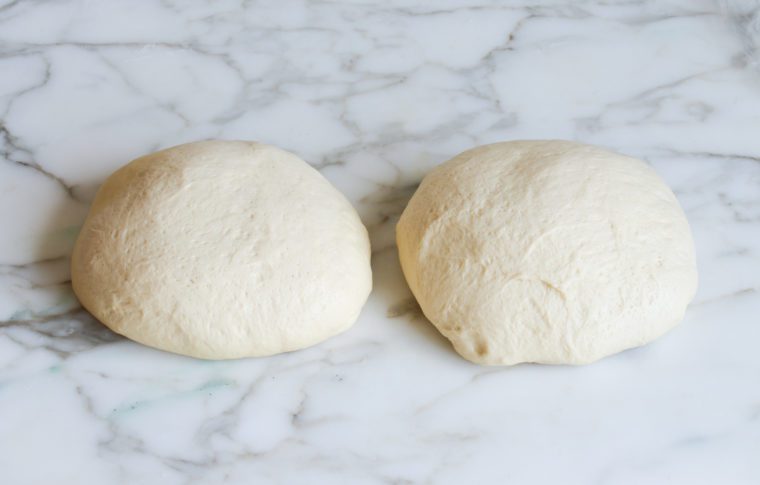
Shape the Dough
When it comes time to shape the pizza dough for baking, you can stretch it into any shape, size, or thickness you like (just keep in mind that a thicker crust will take longer to bake). Simply press and stretch the dough using your hands, dusting with more flour if necessary.
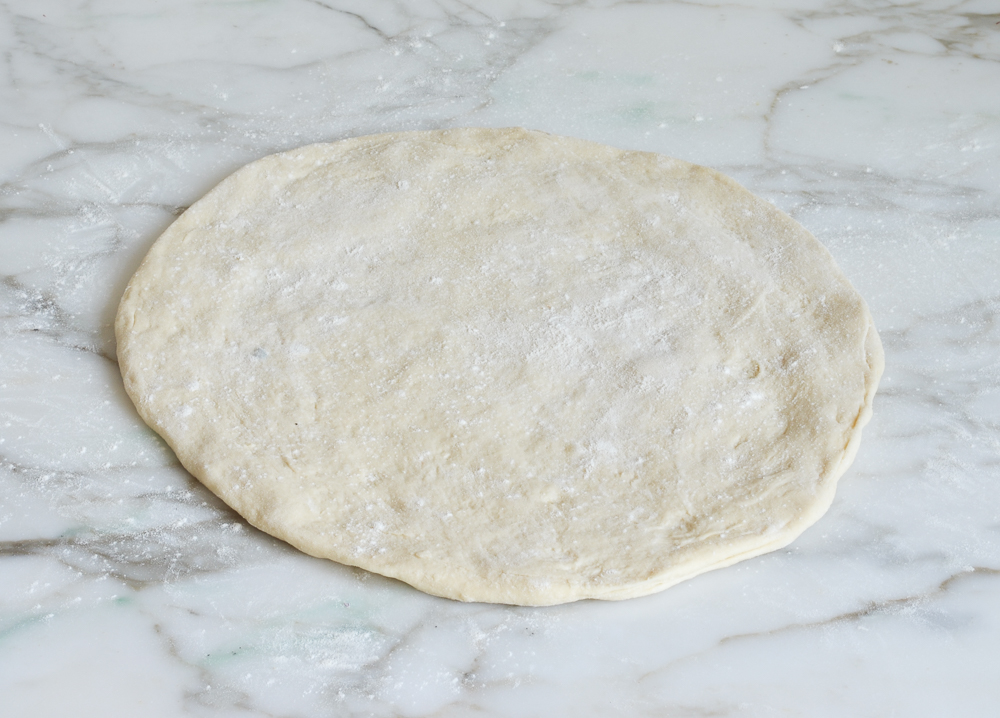
General Baking Instructions
Every pizza recipe is a little different, but as a general guideline:
- Preheat the oven to 500°F and set an oven rack in the bottom position. Dust a 13×18-inch baking sheet lightly with cornmeal.
- Place the stretched dough on the baking sheet, and gently stretch it out again so that it maintains its shape.
- Spread your sauce over the dough, leaving a 1/2-inch border around the edges. Slide the baking sheet into the oven and bake for 5 to 7 minutes, until the crust is partially cooked. Remove from the oven and scatter the cheese and toppings over the sauce. Slide the pan back into the oven and cook until the crust is golden brown and the cheese is melted and bubbling, 4 to 6 minutes more.
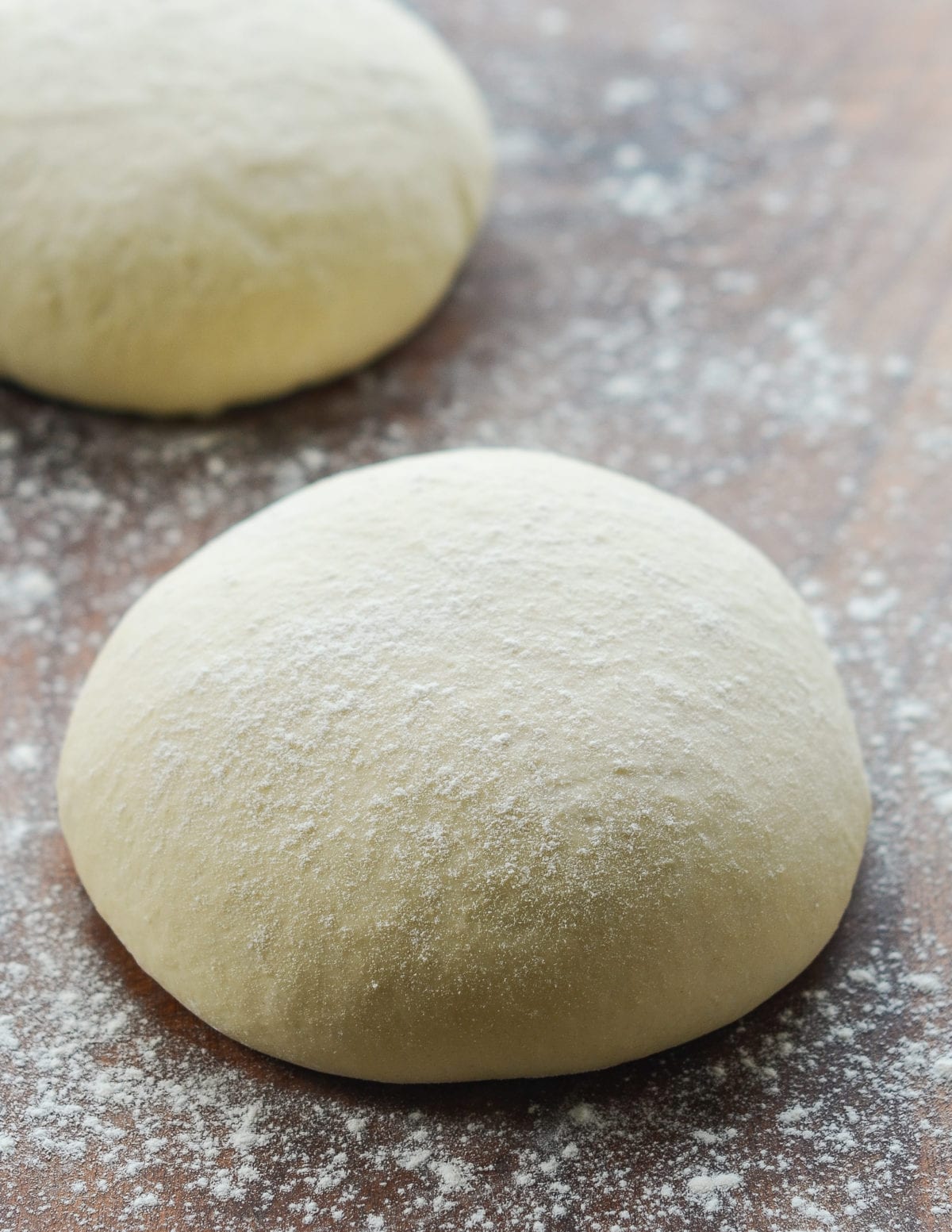
You May Also Like
- Rosemary Focaccia
- Calzones
- Margherita Pizza
- Pesto Pizza with Fresh Tomatoes & Mozzarella
- Challah
- Soft Pretzels
- Stromboli
- Pierogi
Frequently Asked Questions
Yes, if you’re not using the pizza dough right away, after the initial rise, lightly coat the dough ball(s) with olive oil. Place into freezer bag(s) and seal shut, squeezing out all the air. Refrigerate for up to 2 days. When ready to use, let the dough sit out on the countertop for 30 minutes to warm up before stretching. The dough can also be frozen for up to 3 months. When ready to use, defrost in the refrigerator overnight (or for at least 12 hours), and then let it warm up on the countertop for about 30 minutes before stretching and proceeding with your pizza recipe.
Yes but the dough will take longer to rise. To give active dry yeast a boost, you can dissolve it in the warm water and let it sit until frothy, about 10 minutes. Following that, add it to the mixing bowl with the flour, oil, and salt and proceed with the recipe.
Video Tutorial
Pizza Dough
Elevate your homemade pizzas with this simple and delicious pizza dough, made with just five ingredients.
Ingredients
- 4 cups all-purpose flour, spooned into measuring cup and leveled-off, plus more for dusting
- 1 tablespoon instant/quick-rise yeast
- 2¼ teaspoons salt
- ¼ cup extra-virgin olive oil
- 1¼ cups plus 2 tablespoons warm water (see note)
- Cornmeal, for dusting the pan before baking
Instructions
- Combine the flour, yeast, and salt in the bowl of a stand mixer. Stir with a spoon to combine. Add the oil and water and stir until the dough comes together into a shaggy mass. Fit the stand mixer with the dough hook and knead on medium-low speed until the dough is smooth and elastic, 5 to 7 minutes. (Alternatively, you can knead the dough by hand.) The dough should be slightly tacky and cling just to the bottom of the bowl; if it seems too dry during the kneading process, add 1 tablespoon of water. If it seems too sticky, add 1 tablespoon of flour.
- Dust your hands with flour, then gather the dough into a ball and transfer it to a lightly oiled large bowl. Cover the bowl with plastic wrap or a damp kitchen towel and let the dough rise in a warm place until it has doubled in size, 1 to 2 hours.
- When the dough has risen, punch it down and place on a lightly floured surface. Cut the dough in half and roll each piece into a ball.
- If you’re not using the dough right away, lightly coat the dough balls with olive oil. Place into freezer bags and seal shut, squeezing out all the air. Refrigerate for up to 2 days. When ready to use, let the dough sit out on the countertop for 30 minutes to warm up before stretching. The dough can also be frozen for up to 3 months. When ready to use, defrost in the refrigerator overnight (or for at least 12 hours), and then let it warm up on the countertop for about 30 minutes before stretching and proceeding with your pizza recipe.
- If you're planning to use the dough right away, cover the dough balls with a damp kitchen towel and let rest for 15 to 20 minutes (the dough will rise a bit). Using your hands, stretch the dough to the desired shape. Proceed with your pizza recipe, or follow the general baking instructions below.
- General Baking Instructions: Preheat the oven to 500°F and set an oven rack in the bottom position. Dust a 13x18-inch baking sheet lightly with cornmeal. Place the stretched dough on the baking sheet, and gently stretch it out again so that it maintains its shape. Spread your sauce over the dough, leaving a ½-inch border around the edges. Slide the baking sheet into the oven and bake for 5 to 7 minutes, until the crust is partially cooked. Remove from the oven and scatter the cheese and toppings over the sauce. Slide the pan back into the oven and cook until the crust is golden brown and the cheese is melted and bubbling, 4 to 6 minutes more. Remove the pizza from the oven and transfer to a cutting board. Slice and serve.
- Note: Active dry yeast may be used instead of instant yeast, however the dough will take longer to rise. To give active dry yeast a boost, you can dissolve it in the warm water and let it sit until frothy, about 10 minutes. Following that, add it to the mixing bowl with the flour, oil, and salt and proceed with the recipe.
- Note: The water should be warm to the touch — not hot — as anything over 130°F will kill the yeast and keep the dough from rising. It’s not necessary to measure the temperature, but you’re aiming for around 105°F.

Had problems with this pizza dough. Wasn’t very easy to stretch and seemed dry. I used bread flour instead of AP flour so don’t know if that made a difference. And I did add a little more water because it seemed dry. I left it rest several times as I tried to stretch it in the pan but no luck. It required more baking time then the recipe shows and we didn’t really like the taste, kinda bland.
yes, that made a difference. Bread flour has a different amount of gluten to it, and absorbs more water, and yes, that matters greatly and affects the results a lot. You can’t really substitute the main ingredient and then put 1 star because (surprise!) it didn’t turn out as expected. There is a reason there are different types of flour for different purposes and they are marked and sold as such.
Hi Jenn ! I made this recipe, but I am having terrible time stretching the dough into the size/shape for pizza. I was doing it by hand and with a roller, but the dough just shrinks right back to original size:shape. Any recommendations ?
Hi Bill, sorry you’re struggling with this! I’d re-cover the dough with plastic wrap (or a kitchen towel) and let it sit for about 15 minutes. That will help the gluten in the dough relax, and make it easier to stretch. Hope that helps!
Thank you for putting the original recipe up! I had to use the Wayback Machine to find it. The new recipe is fussy and doesn’t do as well as the original. I noticed my first rise was sad and had to do a second rise to get the dough in a usable state.
Thank you again!
Hi Jenn! I received a stand mixer at Christmas and made this recipe 4-5 times with great success. It was amazing to see how the dough became a perfect ball with just the dough hook—all by itself!
But the last two times I’ve made the recipe, using the exact same ingredients and technique, a ball is not forming. Most of the dough is forming a ball, but some of the dough just puddles up on the bottom. Any thoughts? TIA!
Hi Steph, Do you mean some of the dough sticks to the bottom of the bowl? That would be normal as the dough is a bit tacky, but you can try adding 1 to 2 tablespoons more flour towards the end of the kneading process if you’d prefer a drier dough. (Also, I updated the recipe in January to make a larger quantity and also include a bit more water, as I was finding the dough to be a bit dry. Is it possible you originally made the old recipe? If you scroll up a bit over the “You May Also Like” section, you’ll find a link to the old recipe.)
The comments are SO helpful on this site. I just experienced the same thing. I’ve been using a printed version of the old recipe. When I made this one, it didn’t form the ball of dough that I was expecting. Glad to see that’s “as expected” … Fingers crossed this turns out like the old version. 🙂 I’m sure it will be even better!
In your photo it looks like you used an egg which I don’t see listed in the ingredients. However, an egg added to home baked pizza really adds flavor to the dough.
Hi Carol, I see which picture you’re referring to and understand why it looks like I’ve added an egg to the mix, but that’s just the oil that I’ve added to the dry ingredients. Feel free to add an egg to the dough if you’d like though!
Ok I know a number of Italian recipes call for one egg in the dough and it does kick the flavor up a notch. You should try it and see how you like it.
Wonderful dough! I’ve tried a few different pizza dough recipes and yours is my favorite so far. Please add gram measurements for the yeast and salt! The only measurement in grams is for the flour.
Hi Dani, So glad you like this! I usually don’t add grams for teaspoons and tablespoons, but based on what I see online, it looks like 1 tablespoon of instant yeast is the equivalent of just over 9 grams and 2-1/4 teaspoons of salt are the equivalent 13.5 grams. Hope that helps!
Thank you!!
Hello, I am just realizing that you have updated this recipe, can you maybe post the original again?? I loved that one and it was perfect for my 12 inch pizza pans, I really should start writing these things down!!
Thank you
Hi Dani, Yes, I did change it. My rationale was that many people end up using store-bought dough for my pizza recipes. That dough is typically sold in 16-ounce packages and so I figured I should increase the amounts in this recipe to make it consistent. I will add a link to the old recipe soon!
Please do add the link to the old recipe because this one is not turning out as well for me either.
Hi Andrea, Sorry to hear you haven’t had as much success with this! You can find the link to the old recipe immediately under the last picture of the dough.
Hi Jenn! This was my first time making homemade pizza and it turned out great! Used both your dough and sauce recipes.
One thing I’m wondering though – is there a way to get the crust a bit crispier on the outside? Maybe rub some oil on it?
Hi Siobhan, Glad you liked it! Are you partially cooking the crust and sauce before adding the cheese, like I do here? That helps a lot. Otherwise, for a more crispy crust, you could bake it a little longer or rub some oil along the edges.
I did partially cook it, but will try it for a little longer and with a little oil as well. Thanks for the reply, and for all your great recipes. Take care.
The best pizza dough I’ve ever done! We use a pre-heated lodge cast iron pizza pan and skip the preheating portion (and cornmeal).
Thank you so much!
Hi Jenn. This is the best pizza dough recipe. We have pizza every Saturday. Excellent!